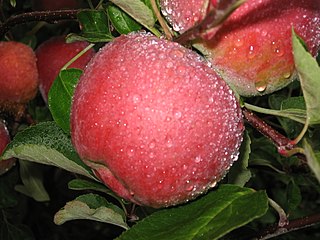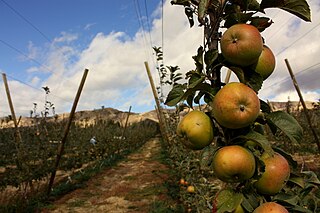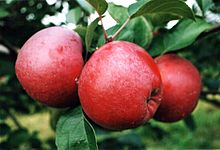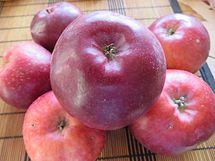
The McIntosh, McIntosh Red, or colloquially the Mac, is an apple cultivar, the national apple of Canada. The fruit has red and green skin, a tart flavour, and tender white flesh, which ripens in late September. In the 20th century, it was the most popular cultivar in Eastern Canada and New England, and is considered an all-purpose apple, suitable both for cooking and eating raw.

Apple juice is a fruit juice made by the maceration and pressing of an apple. The resulting expelled juice may be further treated by enzymatic and centrifugal clarification to remove the starch and pectin, which holds fine particulate in suspension, and then pasteurized for packaging in glass, metal, or aseptic processing system containers, or further treated by dehydration processes to a concentrate.

Cox's Orange Pippin, in Britain often referred to simply as Cox, is an apple cultivar first grown in 1825, at Colnbrook in Buckinghamshire, England, by the retired brewer and horticulturist Richard Cox. Though the parentage of the cultivar is unknown, Ribston Pippin seems a likely candidate. DNA analysis of major apple pedigrees has suggested Margil as the parent of Cox, with Ribston Pippin being another Margil seedling. The variety was introduced for sale by the 1850s by Charles Turner, and grown commercially from the 1860s, particularly in the Vale of Evesham in Worcestershire, and later in Kent. A paper by Howard et al seems to suggest that the Cox Orange Pippin is a hybrid between the Cultivars: Rosemary Russet and Margil based on the SNP data 7

Honeycrisp is an apple cultivar developed at the Minnesota Agricultural Experiment Station's Horticultural Research Center at the University of Minnesota, Twin Cities. Designated in 1974 with the MN 1711 test designation, patented in 1988, and released in 1991, the Honeycrisp, once slated to be discarded, has rapidly become a prized commercial commodity, as its sweetness, firmness, and tartness make it an ideal apple for eating raw. "...The apple wasn't bred to grow, store or ship well. It was bred for taste: crisp, with balanced sweetness and acidity." It has larger cells than most apple cultivars, a trait which is correlated with juiciness, as larger cells are more prone to rupturing instead of cleaving along the cell walls; this rupturing effect is likely what makes the apple taste juicier. The Honeycrisp also retains its pigment well and has a relatively long shelf life when stored in cool, dry conditions. Pepin Heights Orchards delivered the first Honeycrisp apples to grocery stores in 1997. The name Honeycrisp was trademarked by the University of Minnesota, but university officials were unsure of its protection status in 2007. It is now the official state fruit of Minnesota. A large-sized honeycrisp will contain about 113 calories.

'Macoun' apples are a cross between the 'McIntosh' and 'Jersey Black' cultivars. The Macoun was developed at the New York State Agricultural Experiment Station in Geneva, by Richard Wellington. It was first introduced in 1932, and is an eating apple. This apple is excellent for making European style apple pies because it doesn't break down during cooking and remains firm. Macouns are also very popular at roadside stands and pick-your-own farms. Availability is generally October through November. Sugar 13%, acid 6g/litre, vitamin C 4mg/100g.

'Ambrosia' is a cultivar of apple originating in British Columbia, Canada in the early 1990s. The original tree was first cultivated by the Mennell family of Similkameen Valley, British Columbia, who discovered it growing in their orchard.

Empire is the name of a clonally propagated cultivar of apple derived from a seed grown in 1945 by Lester C. Anderson, a Cornell University fruit nutritionist who conducted open pollination research on his various orchards. In 1945, under the direction of A. J. Heinicke, scientists from the New York State Agricultural Experiment Station of Cornell University in Geneva, New York, harvested the Empire seed together with thousands of its siblings. The Geneva teams grew and tested ever dwindling sub-populations of the sibling group until 1966, when the final selection, the Empire, was released to the public at the New York Fruit Testing Association meetings in Geneva. According to the US Apple Association website it is one of the fifteen most popular apple cultivars in the United States.

The Newtown Pippin, also known as Albemarle Pippin, is an American apple that originated in the late 17th or early 18th century and is still cultivated on a small scale. At one time, there were two very similar apple cultivars known as the 'Yellow Newtown' and 'Green Newtown', one of which perhaps originated as a sport of the other.
Table apples are a group of apple cultivars grown for eating raw as opposed to cooking or cidermaking. Table apples are usually sweet and the most prized exhibit particular aroma variations that differentiate them from other apples. D = Dual purpose

An apple is a round, edible fruit produced by an apple tree. Apple trees are cultivated worldwide and are the most widely grown species in the genus Malus. The tree originated in Central Asia, where its wild ancestor, Malus sieversii, is still found. Apples have been grown for thousands of years in Eurasia and were introduced to North America by European colonists. Apples have religious and mythological significance in many cultures, including Norse, Greek, and European Christian tradition.

Aurora Golden Gala is a cross between the apples 'Splendour' and 'Gala'. It was named in 2003 in a nationwide "Name the Apple" contest. Aurora Golden Gala is a yellow dessert apple. It is harvested mid-season. The fruit are medium in size, very crisp, juicy, aromatic, sweet, and they store well.
Nicola is the trade name of the apple cultivar SPA440, a cross between the apples 'Splendour' and 'Gala' made at the Pacific Agri-Food Research Centre (PARC), Summerland, BC. Nicola is a mid-late season apple, typically harvested at 3-4 on the Cornell general Starch chart. Fruit is bicolour, large in size and typically a solid fire engine red over colour, (~80%) over a yellow-green background colour. Fruit is crisp, juicy, and sweet and stores well, with full aromatic flavours developing after several weeks of storage.

The Kentville Research and Development Centre (formerly Atlantic Food and Horticulture Research Centre) is a branch of Agriculture and Agri-Food Canada's national network of 20 research centres stationed across Canada. The site is situated on 464 acres in Kentville, located in Nova Scotia's Annapolis Valley. The Centre's programs address agricultural challenges throughout the Canadian horticultural and food network, but primarily focus on the regional requirements of Atlantic Canada. On September 2, 2003, the centre's staff was recognized by Environment Canada for providing a volunteer climate observation station for a continuous 70 years. On January 26, 2011, and in honour of their centennial celebration, the centre was bestowed with an honorary membership to the Nova Scotia Fruit Growers Association in recognition of the centre's development and support of a sustainable tree fruit industry in Atlantic Canada.

'Creston' is an apple cultivar released by the Pacific Agri-Food Research Centre at Summerland, British Columbia.
Jubilee apple is a modern cultivar of dessert apple, which was developed in the Canadian province of British Columbia by the Summerland Research Station.

Flamenco, also known as Ballerina Obelisk, is a cultivar of domesticated apple that bears apples good for eating fresh, and is grown for its unusual ornamental properties. The tree grows in a straight up columnar style, with many small fruit-bearing branches. 'Flamenco' is one of a series of apple tree cultivars that share a registered trademark under the name Ballerina.

Wijcik McIntosh is a mutation of the McIntosh apple that has a columnar growing habit, meaning that it grows straight and upright, and is spur-bearing, without any major branching. This property is very much appreciated for use as an ornamental plant for itself, and also in the breeding of other apple cultivars, to make them columnar as well.

Melba is a Canadian cultivar of domesticated apple, which was developed by W. T. Macoun at the Central Experimental Farm, in Ottawa, Ontario by crossing a McIntosh with a Liveland Raspberry apple. It has a yellow skin washed with crimson colour. Flesh is extremely white, firm and crisp. Flavor is sweet with hints of tart. There is also a Red Melba mutation which is more red coloured, flesh firmer, and is ripening a few days later in season.
The Pacific Agri-Food Research Centre is an agricultural research centre in British Columbia, Canada. The centre has been historically important in the development of tree fruits. It is administered by Agriculture and Agri-Food Canada and includes sites at Summerland and Agassiz.
Skeena is a cultivar of cherry originating in Canada.



















